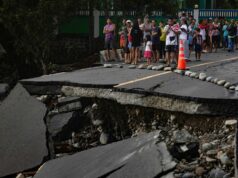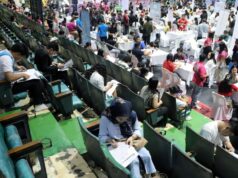ADB maintains bullish outlook for Philippines
THE ASIAN Development Bank (ADB) sees the Philippines sustaining its upward economic growth trajectory on the back of the government’s push for large-scale infrastructure projects.
In its flagship Asian Development Outlook 2018 report, the regional lender projected the country’s gross domestic product (GDP) growth at 6.8% this year, steady from its December projection, and expects the pace to pick up to 6.9% in 2019.

“The Philippine economic growth in 2017 was very strong… driven by robust domestic demand. It’s like a golden age, it has grown at this pace for the several years, and this growth is gonna be sustained in 2018 and 2019,” said Kelly Bird, ADB country director for the Philippines during a press briefing on Wednesday.
“We also believe reforms are in place to support the government’s infrastructure plan that would continue to sustain growth over the medium term. The government has very sound economic policies in place that would mitigate external risks.”
Joseph Zveglich, Jr., director of ADB’s Macroeconomics Research Division, enumerated risks as the escalation of trade tensions between US and China, interest-rate induced capital flow shifts from the US Federal Reserve policy tightening, and increasing private sector debt.
ADB’s forecast falls short of the government’s 7-8% target for this year until 2022. ADB’s projection is a notch higher than the International Monetary Fund’s 6.7% estimate for this year, and the World Bank’s 6.7% estimate for 2018 and 2019, but matches the United Nations Economic and Social Commission for Asia and the Pacific’s 2018 forecast.
ADB noted that Vietnam and Cambodia will lead Southeast Asian growth this year at 7.1% and 7.0%, respectively, followed by the Philippines’, Laos’ and Myanmar’s 6.8%.
For 2019, Myanmar is seen to expand by 7.2%, followed by Cambodia and Laos’ 7.0%, then the Philippines’ 6.9%.
The Philippines will outpace Southeast Asia’s projected 5.2% economic growth for 2018 and 2019, as well as the 6.0% and 5.9% tipped for the same years for “Developing Asia”, which consists of ADB’s 48 Asia-Pacific members.
“No surprises, domestic demand is driving this growth, household spending, but also investments. We expect public sector investment spending on infrastructure to take up spending further. This is related to the government’s ‘Build, Build, Build, infrastructure program,” said Mr. Bird.
He noted that the recently enacted tax reform law “sets the ground for sustained economic growth by allowing greater fiscal space.”
And despite that law’s expected impact on the prices of goods, inflation is projected to remain within bounds at 4.0% and 3.9% for 2018 and 2019 against the central bank’s 2-4% target range for each of those years.
Mr. Bird said that the pick up in inflation “is indicative of a successful economy.”
“At the level of 4% historically, it’s still relatively low. We aren’t particularly concerned on that inflation rate quite yet at this moment.”
He added that “[t]he measure of efficiency in public finance is underspending, which is now well below 3% of the budget.”
“The government is spending much more… they have just been more efficient in spending. There will be huge fiscal space… for aggressive public spending,” Mr. Bird said.
“But the challenge to this is managing… this large ambitious roll out,” he added, while recommending the “strengthening the interagency coordination, improve technical capacity among government agencies.” — Elijah Joseph C. Tubayan



